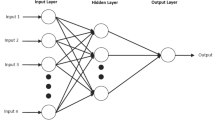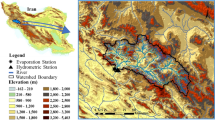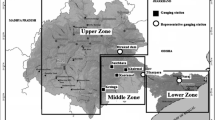Abstract
The ability of a combined model, Wavelet-Generalized Regression Neural Network (WGRNN), is investigated in the current study for the prediction of monthly streamflows. The WGRNN model is obtained by combining two methods, Discrete Wavelet Transform (DWT) and Generalized Regression Neural Network (GRNN), for one-month-ahead streamflow forecasting. The monthly flow data of two stations, the Gerdelli Station on the Canakdere River and the Isakoy Station on the Goksudere River, in the Eastern Black Sea region of Turkey are used in the study. The forecasts of the WGRNN model are tested using the Root Mean Square Error (RMSE), Variance Account For (VAF) and correlation coefficient (R) statistics and the results are compared with those of the single GRNN and Feed Forward Neural Network (FFNN). The comparison results revealed that the WGRNN performs better than the GRNN and FFNN models in monthly streamflow prediction. For the Gerdelli and Isakoy stations, it is found that the WGRNN models with RMSE = 5.31 m3/s, VAF = 52.3%, R = 0.728 and RMSE = 3.36 m3/s, VAF = 55.1%, R = 0.742 in the test period are superior in forecasting monthly streamflows than the best accurate GRNN models with RMSE = 6.39 m3/s, VAF = 30.1%, R = 0.553 and RMSE = 4.19 m3/s, VAF = 30.1%, R = 0.549, respectively.
Similar content being viewed by others
References
Bhattacharjya, R. K., Datta, B. and Satish, M. G. (2009). “Performance of an artificial neural network model for simulating saltwater intrusion process in coastal aquifers when training with noisy data.” KSCE J. of Civ. Eng., Vol. 13, No. 3, pp. 205–215.
Chang, F.-J. and Chen, Y.-C. (2001). “A counterpropagation fuzzyneural network modeling approach to real time streamflow prediction.” Journal of Hydrology, Vol. 245, pp. 153–164.
Chou, C. M. and Wang, R. Y. (2002). “On-line estimation of unit hydrographs using the wavelet-based LMS algorithm.” Hydrol. Sci. J., Vol. 47, No. 5, pp. 721–738.
Cigizoglu, H. K. (2003) “Estimation, forecasting and extrapolation of flow data by artificial neural networks.” Hydrol. Sci. J., Vol. 48, No. 3, pp. 349–361.
Cigizoðlu, H. K. (2005) “Application of generalized regression neural networks to intermittent flow forecasting and estimation.” ASCE J. of Hydrol. Eng., Vol. 10, No. 4, pp. 336–341.
Cigizoglu, H. K. and Kisi, O., (2005). “Flow prediction by three back propagation techniques using k-fold partitioning of neural network training data.” Nordic Hydrology, Vol. 36, No. 1, pp. 49–64.
Coulibaly, P. and Burn, H. D. (2004). “Wavelet analysis of variability in annual Canadian streamflows.” Water Resources Research, Vol. 40, W03105
Karunanithi, N., Grenney, W. J., Whitley, D., and Bovee, K. (1994) “Neural networks for river flow prediction.” J. Comp. Civil Engng ASCE, Vol. 8, No. 2, pp. 201–220.
Kim, B., Kim, S., and Kim, K. (2003). “Modelling of plasma etching using a generalized regression neural network.” Vacuum, Vol. 71, No. 4, pp. 497–503.
Kim, S. (2004). “Neural networks model and embedded stochastic processes for hydrological analysis in South Korea.” KSCE J. of Civ. Eng., Vol. 8, No. 1, pp. 141–148.
Kim, T.-W. (2006). “Monthly precipitation forecasting using rescaling errors.” KSCE J. of Civ. Eng., Vol. 10, No. 2, pp. 137–143.
Kisi, O. (2004). “River flow modeling using artificial neural networks.” ASCE J. of Hydrol. Eng., Vol. 9, No. 1, pp. 60–63.
Kisi, O. (2005). “Suspended sediment estimation using neuro-fuzzy and neural network approaches.” Hydrol. Sci. J., Vol. 50, No. 4, pp. 683–696.
Kisi, O. (2006). “Generalized regression neural networks for evapotranspiration modelling.” Hydrol. Sci. J., Vol. 51, No. 6, pp. 2006, 1092–1105.
Kisi, O. (2007a). “Evapotranspiration modelling from climatic data using a neural computing technique.” Hydrological Processes, Vol. 21, No. 14, pp. 1925–1934.
Kisi, O. (2007b). “Streamflow forecasting using different artificial neural network algorithms.” ASCE J. of Hydrol. Eng., Vol. 12, No. 5, pp. 532–539.
Kisi, O. (2008a). “Constructing neural network sediment estimation models using a data-driven algorithm.” Mathematics and Computers in Simulation, Vol. 79, No. 1, pp. 94–103.
Kisi, O. (2008b). “River flow forecasting and estimation using different artificial neural network techniques.” Hydrology Research, Vol. 39, No. 1, pp. 27–40.
Kisi, O. (2009). “Wavelet regression model as an alternative to neural networks for monthly streamflow forecasting.” Hydrological Processes, Vol. 23, No. 25, pp. 3583–3597.
Kisi, O. and Uncuoglu E. (2005). “Comparison of three backpropagation training algorithms for two case studies.” Indian J. of Eng. & Materials Sciences, Vol. 12, No. 5, pp 443–450.
Kucuk, M. and Agiralioglu, N. (2006). “Wavelet regression techniques for streamflow predictions.” Journal of Applied Statistic, Vol. 33, No. 9, pp. 943–960.
Labat, D. (2005). “Recent advances in wavelet analyses: Part 1. A review of concepts.” Journal of Hydrology, Vol. 314, Nos. 1–4, pp. 275–288.
Labat, D., Ababou, R., and Mangin, A. (2000). “Rainfall-runoff relations for karstic springs. Part II: continuous wavelet and discrete orthogonal multiresolution analyses.” Journal of Hydrology, Vol. 238, No. 3–4, pp. 149–178.
Labat, D. Ronchail, J., and Guyot, J. L. (2005). “Recent advances in wavelet analyses: Part 2 — Amazon, Parana, Orinoco and Congo discharges time scale variability.” Journal of Hydrology, Vol. 314, No. 1–4, pp. 289–311.
Lee, S.-Y., Chung, S.-H., and Oh, J.-K. (2004). “demand forecasting based infrastructure asset management.” KSCE J. of Civ. Eng., Vol. 8, No. 2, pp. 165–172.
Lu, R. Y. (2002). “Decomposition of interdecadal and interannual components for North China rainfall in rainy season.” Chinese Journal of Atmosphere (in Chinese), Vol. 26, pp. 611–624.
Ma, P. Y. (2006). A fresh engineering approach for the forecast of financial index volatility and hedging strategies, PhD Thesis, Quebec University, Montreal, Canada.
Mallat, S. G. (1989). “A theory for multi resolution signal decomposition: The wavelet representation.” IEEE Transactions on Pattern Analysis and Machine Intelligence, Vol. 11, No. 7, pp. 674–693.
Ning, M. and Yunping, C. (1998). An ANN and wavelet transformation based method for short term load forecast, Energy Management and Power Delivery. In: International Conferences, Vol. 2, pp. 405–410.
Partal, T. and Küçük, M. (2006). “Long-term trend analysis using discrete wavelet components of annual precipitations measurements in Marmara region (Turkey). Physics and Chemistry of the Earth. 31-1189-1200.
Sahoo, G. B. and Ray, C. (2006). “Flow forecasting for a Hawaii stream using rating curves and neural networks.” Journal of Hydrology, Vol. 317, No. 1–2, pp. 63–80.
Sivakumar, B., Jayawardena, A.W., and Fernando, T. M. K. G. (2002). “River flow forecasting: use of phase space recostruction and artificial neural networks approaches.” Journal of Hydrology, Vol. 265, No. 1–4, pp. 225–245.
Smith, J. and Eli, R. N. (1995) “Neural-network models of rainfallrunoff process.” J. Water Resour. Plan. Mgmt ASCE, Vol. 121, No. 6, pp. 499–508.
Smith, L. C., Turcotte, D. L., and Isacks, B. (1998). “Stream flow characterization and feature detection using a discrete wavelet transform.” Hydrological Processes, Vol. 12, No. 2, pp. 233–249.
Specht, D. F. (1991) “A general regression neural network.” IEEE Trans. Neural Networks, Vol. 2, No. 6, pp. 568–576.
Sudheer, K. P. and Jain, S. K. (2003). “radial basis function neural network for modeling rating curves.” ASCE J. of Hydrol. Eng., Vol. 8, No. 3, pp. 161–164.
Sudheer, K. P., Gosain, A. K., and Ramasastri, K. S. (2002a). “A datadriven algorithm for constructing artificial neural network rainfallrunoff models.” Hydrological Processes, Vol. 16, No. 6, pp. 1325–1330.
Tokar, A. S. and Johnson, P. A. (1999) “Rainfall-runoff modeling using artificial neural networks.” ASCE J. of Hydrol. Eng., Vol. 4, No. 3, pp. 232–239.
Tsoukalas, L. H. and Uhrig, R. E. (1997). Fuzzy and neural approaches in engineering, John Wiley and Sons, Inc., New York, p. 587.
Xingang, D., Ping, W., and Jifan, C. (2003). “Multiscale characteristics of the rainy season rainfall and interdecadal decaying of summer monsoon in North China.” Chinese Science Bulletin, Vol. 48, pp. 2730–2734.
Wang, W. and Ding, J. (2003). “Wavelet network model and its application to the prediction of the hydrology.” Nature and Science, Vol. 1, No. 1, pp. 67–71.
Zealand, C. M., Burn, D. H., and Simonovic, S. P. (1999). “Short term streamflow forecasting using artificial neural networks.” Journal of Hydrology, Vol. 214, No. 1–4, pp. 32–48.
Author information
Authors and Affiliations
Corresponding author
Rights and permissions
About this article
Cite this article
Kişi, Ö. A combined generalized regression neural network wavelet model for monthly streamflow prediction. KSCE J Civ Eng 15, 1469–1479 (2011). https://doi.org/10.1007/s12205-011-1004-4
Received:
Revised:
Accepted:
Published:
Issue Date:
DOI: https://doi.org/10.1007/s12205-011-1004-4




